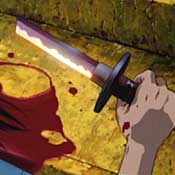by Owen Thomas
|
Perhaps the first, and certainly the most famous and influential depiction of a samurai antihero arrived in 1970 when "Lone Wolf and Cub" began publication. "Lone Wolf and Cub" has sold over six million copies in Japan, and has been published in translation around the world, including the first complete American edition published by Dark Horse Comics this year. In Japan it spawned six movies, four plays, a TV series, and five records. It helped to usher in a new, grittier, more realistic, style of art in "jidaimono" (historical manga). Itto Ogami, the protagonist, is a ronin who has been forced to wander the countryside working as an assassin for hire, seeking revenge on his wife's killers. His only companion is his infant son whom he carries with him even into battle. Like "Samurai X", "Lone Wolf and Cub" combines graphic violence with surprisingly tender human relationships. The Bushido code, to which samurai were supposed to adhere, stressed absolute non-attachment to the material world, personal relationships and life itself. The conflict between that code and Ogami's love for his son, and between his innate humanity and the carnal violence that defines his life, provide the story with thematic depth unusual in the genre. It was among the first "jidaimono" to use the dualities inherent in the role of a samurai to examine serious dramatic themes. Several of those same themes shape Kenshin's story in "Samurai X." Like Ogami he is an assassin. And as with Ogami, Kenshin's emotional attachments and professional detachment are in conflict. Both characters are more conflicted - more uncertain about their code, their own virtue, and their lives - than previous samurai characters. Kenshin Himura clearly follows in the vein of Itto Ogami, but "Samurai X" goes even further than "Lone Wolf and Cub" or other predecessors in its critique of the samurai ethos. Just as the idealized images of samurai were symbols of a conventional set of ideals, Kenshin represents a dramatically new ideal in the history of samurai fiction - an ideal strikingly at odds with the traditional values of the samurai class, and their role in Japanese society and culture. "Samurai X" weaves in elements of Musashi, Ogami, Genzai, and others; but the center of the story is an imaginative exploration of that choice made by Kenshin, to renounce the honorable position of servant to his lord. In fact, Kenshin rejects the life of a swordsman entirely. Moreover, he does so in favor of the life of a farmer. Though traditionally peasants (including farmers) were regarded as the second highest class, under samurai, they were heavily taxed, often poor and treated badly by the rest of society. Kenshin's devotion to the way of the sword, his service to his lord, stoicism, fearlessness, and self-sacrifice, represent the ideals of the samurai; yet in the story of "Samurai X" those ideals lead him to anguish, remorse, frustration and betrayal. It is common for samurai characters to lead tragic lives, after all the ultimate proof of their virtue (and a convenient ending to any story) is a good death. What is unique about Kenshin is that choosing the way of the warrior leads to his misery. Eventually he acknowledges that Hiko was right, that killing accomplishes nothing and, once begun, never ends. Kenshin repudiates the value of his own obediance, excellence, and sacrifice and instead finds greater happiness and greater pride in the humblest of vocations than as the greatest of swordsmen.
Critical depictions of individual samurai have precedent, but even most modern perspectives in Japanese culture continue to revere the code and way of the samurai. In Akira Kurosawa's landmark "The Seven Samurai" a group of ronin hired to defend a village against the raids and robbery of bandits (many of whom are also ronin), begrudgingly accept and educate the buffoonish Kikuchiyo in the way of the samurai. However it is Kikuchiyo who gives an impassioned speech excoriating the other samurai for their ethics. He points out that villagers hate and fear samurai because so many samurai steal and kill, and argues that their code which demands total service to their lord cannot be more important than also being faithful to and serving the people. Kikuchiyo (movingly) expresses anachronistic, modern, humanist values; but in the climactic battle Kikuchiyo finally realizes what it means to be a samurai and how noble it is to sacrifice his self. Which he then does. However critical it may be of an individual samurai's actions, or inadequate social understanding, ultimately "The Seven Samurai" portrays the essence of the samurai as profoundly noble, though inevitably tragic. By contrast, the way of the sword, and Kenshin's duty to his lord, are explicitly themselves the cause of Kenshin's torment. ADV, by retaining the title "Samurai X," contributes to the evolution of the literary icon of the samurai. Kenshin, as he is portrayed in "Samurai X," is a profoundly sympathetic and romantic character. He evokes the most popular and famous samurai in history and fiction, and early in "Samurai X" he embodies the most admired traditional values of the samurai. His story however is surprisingly different from its predecessors in the genre in that it dramatizes Kenshin's discovery that freedom, self-reliance and love are more rewarding and ennobling than duty, stoicism and sacrifice. Samurai though he may be, it appears that Kenshin would rather be a cowboy. |
||||
|
Samurai X / Rurouni Kenshin © Nobuhiro Watsuki / Shueisha / Fuji TV / SPE Visual Works / AD Vision. |
